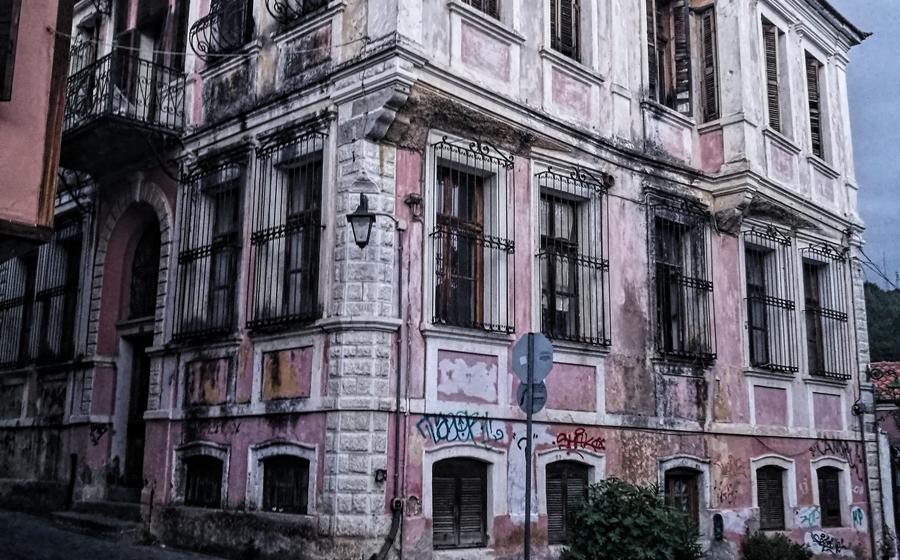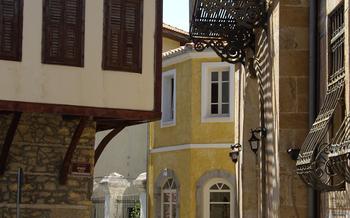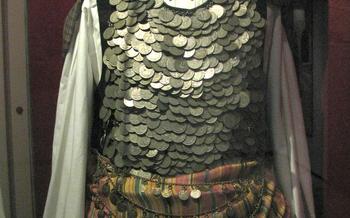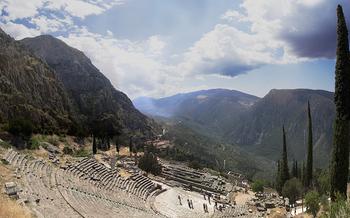
The House of Shadow
- Historical Background
- Location:
- Architecture
- Interior Design
- Museum Exhibits
- Guided Tours
- Admission Fees and Hours:
- Visitor Etiquette
- Souvenirs and Gifts:
- Accessibility:
- Educational Programs
- Events and Workshops
- Nearby Attractions:
- Insider Tip:
Historical Background
Xanthi, a city nestled in northeastern Greece, holds a rich cultural heritage, shaped by diverse influences throughout history. During the Ottoman rule, which lasted for over five centuries, Xanthi flourished as a significant trade and commercial center. The city's strategic location at the crossroads of major trade routes made it a melting pot of cultures, blending Greek, Turkish, and Jewish traditions. The House of Shadow, a striking architectural gem in Xanthi, stands as a testament to this vibrant past. Built in the 18th century by a wealthy tobacco merchant, the house embodies the architectural style of the Ottoman era, showcasing intricate carvings, decorative elements, and a unique blend of Eastern and Western influences.
Location:
The House of Shadow is situated in the heart of Xanthi's Old Town, a captivating district brimming with historical charm and architectural wonders. To reach this hidden gem, visitors can stroll along the picturesque cobblestone streets until they stumble upon 17 Omirou Street. The house stands proudly on this serene street, inviting visitors to step into a world of history and mystery.
Nearby, visitors can explore a wealth of other attractions that showcase Xanthi's rich heritage. The Old Town is home to several museums, including the Folk and Anthropological Museum, which delves into the region's cultural traditions. The imposing castle of Xanthi, perched atop a hill, offers breathtaking panoramic views of the city and the surrounding countryside.
Finding parking in the vicinity of the House of Shadow is relatively straightforward. Visitors can utilize the designated parking areas located within walking distance of the house. The Old Town is easily accessible by foot, allowing visitors to immerse themselves in the historical ambiance as they make their way to this captivating attraction.
Architecture
The House of Shadow is an architectural marvel, showcasing a unique blend of Ottoman, Islamic, and European influences. Its exterior facade is adorned with intricate carvings, delicate latticework, and colorful tiles that create a captivating visual tapestry. The house is constructed using traditional materials such as stone, wood, and mud bricks, which contribute to its authenticity and rustic charm.
Inside, the House of Shadow boasts a series of interconnected chambers and courtyards, each adorned with its own distinctive style. The main courtyard serves as the heart of the house, featuring a central fountain surrounded by intricate arches and columns. The rooms are spacious and airy, with high ceilings and large windows that allow natural light to flood in, creating a warm and inviting ambiance.
One of the most striking features of the House of Shadow is its intricate carvings. The walls, ceilings, and doorways are adorned with a profusion of geometric patterns, floral motifs, and calligraphic inscriptions, each meticulously crafted by skilled artisans. These carvings not only enhance the aesthetic appeal of the house but also reflect the rich cultural heritage of Xanthi.
The House of Shadow is a true testament to the architectural ingenuity of the Ottoman era. Its unique design, combined with its historical significance, makes it a must-visit destination for anyone interested in architecture, history, or cultural exploration.
Interior Design
The interior of the House of Shadow is a testament to the exquisite craftsmanship and attention to detail that characterized Ottoman architecture. The house is divided into several rooms, each with a distinct function and design. The main hall, or selamlik, is the largest and most impressive room in the house. It features a high ceiling, intricate carvings, and decorative elements that reflect the opulence of the Ottoman era.
The selamlik was used to receive guests and conduct official business. It is furnished with traditional Ottoman furniture, including low tables, divans, and cushions. The walls are adorned with colorful tapestries, carpets, and paintings, creating a warm and inviting atmosphere.
The private quarters of the house, or haremlik, are located on the upper floor. This section of the house was reserved for women and children. The rooms are smaller and more intimate, with a focus on comfort and privacy. The haremlik features a variety of rooms, including bedrooms, a kitchen, and a bathroom.
The House of Shadow is adorned with a collection of traditional furnishings, artifacts, and decorations that offer a glimpse into the lives of its former occupants. Visitors can admire the intricate carvings on the wooden doors and furniture, the colorful tiles that adorn the walls, and the delicate textiles that hang from the windows.
Museum Exhibits
The House of Shadow is not only a testament to architectural brilliance but also a treasure trove of cultural and historical artifacts. Its museum exhibits are thoughtfully curated to provide visitors with a deeper understanding of the region's rich heritage. The displays showcase a diverse collection of items, including traditional costumes, jewelry, pottery, and artifacts from daily life during the Ottoman period. Visitors can marvel at the intricate craftsmanship and unique designs that reflect the cultural influences of the time.
Interactive exhibits and multimedia presentations bring history to life, allowing visitors to engage with the stories and experiences of the people who once inhabited the house. These exhibits provide a glimpse into their daily lives, their customs, and the challenges they faced. The museum also features a section dedicated to the history of Xanthi, showcasing important events and personalities that shaped the city's development. Through these exhibits, the House of Shadow offers an immersive journey into the past, providing visitors with a deeper appreciation for the cultural legacy of the region.
Guided Tours
The House of Shadow offers guided tours to provide visitors with a deeper understanding of its history and significance. These tours are available in multiple languages, including English, Greek, and French. They typically last for about an hour and are led by experienced guides who share fascinating insights and anecdotes about the house and its former inhabitants. By joining a guided tour, visitors can learn more about the architectural features, interior design, and unique artifacts displayed within the house. The guides also shed light on the cultural and historical context of the House of Shadow, making the visit even more enriching and memorable for visitors.
Admission Fees and Hours:
Visiting the House of Shadow is a budget-friendly experience. The admission fee is minimal, offering excellent value for the wealth of history and culture it provides. Concessions are available for students, seniors, and groups, making it accessible to a wide range of visitors.
The House of Shadow welcomes visitors during specific hours of operation. It is open throughout the week, except for Mondays, allowing flexibility for tourists and locals alike. The opening hours provide ample time to explore the house's intricate details, admire the exhibits, and soak in the historical atmosphere.
Plan your visit during the morning hours to avoid crowds and fully immerse yourself in the tranquility of the house. Alternatively, visit during the evening hours to experience a different ambiance as the house takes on a mystical charm under the soft glow of the setting sun.
Whether you're a history buff, an architecture enthusiast, or simply seeking a unique cultural experience, the House of Shadow is a must-visit attraction in Xanthi. Its affordable admission fees and flexible hours make it an accessible and rewarding destination for travelers of all interests.
Visitor Etiquette
While exploring the House of Shadow, visitors are expected to adhere to certain rules and etiquette to ensure the preservation and respect of this historical site. Photography is permitted within the house, but using flash or tripods is strictly prohibited to avoid damaging the delicate artifacts and furnishings. Touching or handling the exhibits is prohibited as they are irreplaceable cultural treasures. Visitors are encouraged to maintain a respectful tone and volume while inside the house to create a peaceful environment for everyone. By following these guidelines, visitors can contribute to the preservation and appreciation of this unique cultural heritage for generations to come.
Souvenirs and Gifts:
The House of Shadow offers a unique opportunity to purchase souvenirs and gifts inspired by its rich history and cultural significance. Visitors can find a variety of items to commemorate their visit, including replicas of traditional artifacts, handmade crafts, and books about the house and its history. These souvenirs are available in the museum shop, which is located within the house itself. Visitors can browse a carefully curated selection of items that are both authentic and meaningful. Whether looking for a small keepsake or a special gift for a loved one, the museum shop at the House of Shadow is sure to have something to suit every taste.
Accessibility:
The House of Shadow is committed to providing an inclusive and accessible experience for all visitors, regardless of their abilities. To ensure that everyone can enjoy the house and its exhibits, several accessibility features have been implemented.
The main entrance to the house is wheelchair accessible, and ramps have been installed to facilitate movement throughout the building. Visitors with disabilities can also request the use of a wheelchair or scooter, subject to availability.
Inside the house, the exhibits are arranged in a way that is easy to navigate for visitors with mobility impairments. Wide aisles and clear pathways allow for comfortable movement, and interactive exhibits are positioned at accessible heights.
For visitors who are deaf or hard of hearing, audio guides with closed captions are available. Additionally, the museum staff is trained to provide assistance and interpretation to visitors with hearing impairments.
The House of Shadow also offers accessible tours for visitors with cognitive disabilities. These tours are designed to provide a sensory-rich experience that is tailored to the needs of individuals with learning difficulties or autism spectrum disorder.
Overall, the House of Shadow strives to create a welcoming and inclusive environment where everyone can learn about and appreciate the rich history of Xanthi and the significance of the House of Shadow.
Educational Programs
The House of Shadow offers a range of educational programs and workshops designed to engage and educate visitors of all ages. These programs aim to promote cultural heritage, history, and traditional arts and crafts associated with the region.
One of the popular programs is the "Traditional Crafts Workshop," where visitors can learn about and participate in traditional crafts such as pottery, weaving, and woodworking. Under the guidance of skilled artisans, participants can create their own unique souvenirs to take home.
For children and school groups, the House of Shadow offers interactive workshops that focus on history, art, and storytelling. Through hands-on activities, games, and storytelling sessions, children can learn about the significance of the house, its architecture, and the cultural heritage of Xanthi.
The educational programs at the House of Shadow provide a unique opportunity for visitors to gain insights into the region's rich history and traditions while fostering creativity and cultural understanding.
Events and Workshops
The House of Shadow is not just a museum but also a vibrant cultural hub that hosts a variety of events and workshops throughout the year. These events and workshops are designed to engage visitors of all ages and provide opportunities for learning, creativity, and cultural exchange.
One of the most popular events is the annual "Xanthi Shadow Festival" held during the summer months. This festival celebrates the unique cultural heritage of Xanthi and features a range of activities, including traditional music performances, dance workshops, art exhibitions, and storytelling sessions. Visitors can immerse themselves in the rich cultural traditions of Xanthi and experience the vibrant energy of the city.
In addition to the annual festival, the House of Shadow also hosts regular workshops on various topics related to art, history, and culture. These workshops are led by experienced professionals and provide visitors with the opportunity to learn new skills, engage in creative activities, and deepen their understanding of the region's heritage.
For those interested in photography, there are workshops focused on capturing the unique architectural details and atmospheric ambiance of the House of Shadow. Art workshops offer hands-on experiences in traditional crafts such as pottery, weaving, and embroidery, allowing visitors to create their own unique souvenirs.
The House of Shadow also hosts educational workshops for school groups and families. These workshops are designed to make learning about history and culture fun and interactive. Children can participate in storytelling sessions, hands-on activities, and role-playing games that bring the past to life.
Whether you are interested in art, history, culture, or simply looking for a unique and enriching experience, the events and workshops at the House of Shadow offer something for everyone. Be sure to check the museum's website or social media pages for upcoming events and workshops during your visit.
Nearby Attractions:
Xanthi offers a plethora of other attractions for visitors to explore after immersing themselves in the history and culture of the House of Shadow. One significant landmark is the Old Town of Xanthi, a charming neighborhood known for its well-preserved Ottoman-era architecture and narrow cobblestone streets. Visitors can wander through the picturesque alleys, admire the traditional houses, and discover hidden gems like small shops, cafes, and restaurants.
For those interested in history, the Xanthi Archaeological Museum houses a collection of artifacts from the region, providing a glimpse into the area's rich past. The museum displays archaeological findings from prehistoric times to the Byzantine period, offering visitors a deeper understanding of Xanthi's history and cultural heritage.
Nature enthusiasts will find solace in the nearby Xanthi Forest, a vast expanse of greenery located just a short drive from the city. The forest offers a serene escape with opportunities for hiking, biking, and picnicking amidst the tranquil surroundings. Visitors can explore the diverse flora and fauna, including lush forests, sparkling rivers, and breathtaking views of the surrounding landscapes.
These attractions, along with many others, make Xanthi a captivating destination for travelers seeking a blend of history, culture, and natural beauty. Whether you're interested in exploring ancient ruins, discovering local cuisine, or immersing yourself in nature, Xanthi has something to offer every visitor.
Insider Tip:
For an unforgettable experience, plan your visit to the House of Shadow during the annual Xanthi Carnival, held in late February or early March. During this vibrant festival, the streets of Xanthi come alive with colorful parades, traditional music, and dancing. Immerse yourself in the festive atmosphere as you explore the House of Shadow, adorned with carnival decorations and illuminated by the flickering lights of lanterns. This unique opportunity to witness the fusion of history and culture will create lasting memories of your visit to Xanthi.








